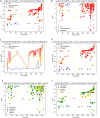Exploring TTN variants as genetic insights into cardiomyopathy pathogenesis and potential emerging clues to molecular mechanisms in cardiomyopathies
- PMID: 38438525
- PMCID: PMC10912352
- DOI: 10.1038/s41598-024-56154-7
Exploring TTN variants as genetic insights into cardiomyopathy pathogenesis and potential emerging clues to molecular mechanisms in cardiomyopathies
Abstract
The giant protein titin (TTN) is a sarcomeric protein that forms the myofibrillar backbone for the components of the contractile machinery which plays a crucial role in muscle disorders and cardiomyopathies. Diagnosing TTN pathogenic variants has important implications for patient management and genetic counseling. Genetic testing for TTN variants can help identify individuals at risk for developing cardiomyopathies, allowing for early intervention and personalized treatment strategies. Furthermore, identifying TTN variants can inform prognosis and guide therapeutic decisions. Deciphering the intricate genotype-phenotype correlations between TTN variants and their pathologic traits in cardiomyopathies is imperative for gene-based diagnosis, risk assessment, and personalized clinical management. With the increasing use of next-generation sequencing (NGS), a high number of variants in the TTN gene have been detected in patients with cardiomyopathies. However, not all TTN variants detected in cardiomyopathy cohorts can be assumed to be disease-causing. The interpretation of TTN variants remains challenging due to high background population variation. This narrative review aimed to comprehensively summarize current evidence on TTN variants identified in published cardiomyopathy studies and determine which specific variants are likely pathogenic contributors to cardiomyopathy development.
Keywords: TTN; Cardiomyopathy; Genetic; Titin; Variant.
© 2024. The Author(s).
Conflict of interest statement
The authors declare no competing interests.
Figures




Similar articles
-
Novel heterozygous truncating titin variants affecting the A-band are associated with cardiomyopathy and myopathy/muscular dystrophy.Mol Genet Genomic Med. 2020 Oct;8(10):e1460. doi: 10.1002/mgg3.1460. Epub 2020 Aug 20. Mol Genet Genomic Med. 2020. PMID: 32815318 Free PMC article.
-
A Review of the Giant Protein Titin in Clinical Molecular Diagnostics of Cardiomyopathies.Front Cardiovasc Med. 2016 Jul 21;3:21. doi: 10.3389/fcvm.2016.00021. eCollection 2016. Front Cardiovasc Med. 2016. PMID: 27493940 Free PMC article. Review.
-
Amino Acid-Level Signal-to-Noise Analysis Aids in Pathogenicity Prediction of Incidentally Identified TTN-Encoded Titin Truncating Variants.Circ Genom Precis Med. 2021 Feb;14(1):e003131. doi: 10.1161/CIRCGEN.120.003131. Epub 2020 Nov 23. Circ Genom Precis Med. 2021. PMID: 33226272 Free PMC article.
-
Targeted 46-gene and clinical exome sequencing for mutations causing cardiomyopathies.Mol Cell Probes. 2015 Oct;29(5):308-14. doi: 10.1016/j.mcp.2015.05.004. Epub 2015 May 12. Mol Cell Probes. 2015. PMID: 25979592
-
Titin in muscular dystrophy and cardiomyopathy: Urinary titin as a novel marker.Clin Chim Acta. 2019 Aug;495:123-128. doi: 10.1016/j.cca.2019.04.005. Epub 2019 Apr 5. Clin Chim Acta. 2019. PMID: 30959043 Review.
Cited by
-
Fentanyl and Sudden Death-A Postmortem Perspective for Diagnosing and Predicting Risk.Diagnostics (Basel). 2024 Sep 9;14(17):1995. doi: 10.3390/diagnostics14171995. Diagnostics (Basel). 2024. PMID: 39272779 Free PMC article. Review.
-
Genotype-phenotype insights of pediatric dilated cardiomyopathy.Front Pediatr. 2025 Jan 31;13:1505830. doi: 10.3389/fped.2025.1505830. eCollection 2025. Front Pediatr. 2025. PMID: 39959410 Free PMC article. Review.
-
Development of an alkaliptosis-related lncRNA risk model and immunotherapy target analysis in lung adenocarcinoma.Front Genet. 2025 Apr 8;16:1573480. doi: 10.3389/fgene.2025.1573480. eCollection 2025. Front Genet. 2025. PMID: 40264452 Free PMC article.
-
TTN:c.12478del in proximal I-band of titin represents a common molecular cause of dilated cardiomyopathy in Slovenian patients.Orphanet J Rare Dis. 2025 Feb 28;20(1):92. doi: 10.1186/s13023-025-03613-7. Orphanet J Rare Dis. 2025. PMID: 40022161 Free PMC article.
-
An Analysis of the Genetic Diversity, Genetic Structure, and Selection Signal of Beagle Dogs Using SNP Chips.Genes (Basel). 2025 Mar 21;16(4):358. doi: 10.3390/genes16040358. Genes (Basel). 2025. PMID: 40282318 Free PMC article.
References
-
- Ormerod, J.O. and A. Yavari, Cardiomyopathies. Medicine, 2022.
-
- Maron BJ, et al. Contemporary definitions and classification of the cardiomyopathies: An American heart association scientific statement from the council on clinical cardiology, heart failure and transplantation committee; quality of care and outcomes research and functional genomics and translational biology interdisciplinary working groups; and council on epidemiology and prevention. Circulation. 2006;113(14):1807–1816. doi: 10.1161/CIRCULATIONAHA.106.174287. - DOI - PubMed
Publication types
MeSH terms
Substances
LinkOut - more resources
Full Text Sources
Medical

